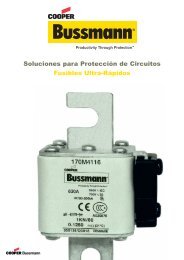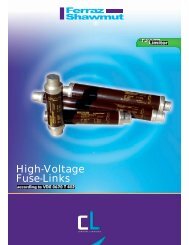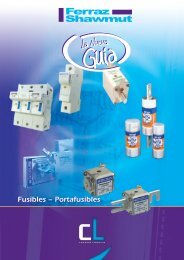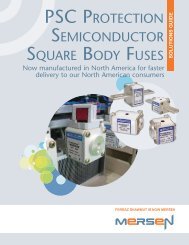Bussmann
You also want an ePaper? Increase the reach of your titles
YUMPU automatically turns print PDFs into web optimized ePapers that Google loves.
Fuse Technology<br />
<strong>Bussmann</strong> ®<br />
Circuit Protection<br />
Electrical distribution systems are often quite complicated. They<br />
cannot be absolutely fail-safe. Circuits are subject to destructive<br />
overcurrents. Harsh environments, general deterioration, accidental<br />
damage, damage from natural causes, excessive expansion,<br />
and/or overloading of the electrical distribution system are<br />
factors which contribute to the occurrence of such overcurrents.<br />
Reliable protective devices prevent or minimize costly damage to<br />
transformers, conductors, motors, and the other many components<br />
and loads that make up the complete distribution system.<br />
Reliable circuit protection is essential to avoid the severe monetary<br />
losses which can result from power blackouts and prolonged<br />
downtime of facilities. It is the need for reliable protection, safety,<br />
and freedom from fire hazards that has made the fuse a widely<br />
used protective device.<br />
Overcurrents<br />
An overcurrent is either an overload current or a short-circuit current.<br />
The overload current is an excessive current relative to normal<br />
operating current, but one which is confined to the normal<br />
conductive paths provided by the conductors and other components<br />
and loads of the distribution system. As the name implies,<br />
a short-circuit current is one which flows outside the normal conducting<br />
paths.<br />
Overloads<br />
Overloads are most often between one and six times the normal<br />
current level. Usually, they are caused by harmless temporary<br />
surge currents that occur when motors are started-up or transformers<br />
are energized. Such overload currents, or transients, are<br />
normal occurrences. Since they are of brief duration, any temperature<br />
rise is trivial and has no harmful effect on the circuit<br />
components. (It is important that protective devices do not react<br />
to them.)<br />
Continuous overloads can result from defective motors (such as<br />
worn motor bearings), overloaded equipment, or too many loads<br />
on one circuit. Such sustained overloads are destructive and<br />
must be cut off by protective devices before they damage the<br />
distribution system or system loads. However, since they are of<br />
relatively low magnitude compared to short-circuit currents,<br />
removal of the overload current within minutes will generally prevent<br />
equipment damage. A sustained overload current results in<br />
overheating of conductors and other components and will cause<br />
deterioration of insulation, which may eventually result in severe<br />
damage and short-circuits if not interrupted.<br />
Short-Circuits<br />
Whereas overload currents occur at rather modest levels, the<br />
short-circuit or fault current can be many hundred times larger<br />
than the normal operating current. A high level fault may be<br />
50,000A (or larger). If not cut off within a matter of a few thousandths<br />
of a second, damage and destruction can become<br />
rampant—there can be severe insulation damage, melting of<br />
conductors, vaporization of metal, ionization of gases, arcing,<br />
and fires. Simultaneously, high level short-circuit currents can<br />
develop huge magnetic-field stresses. The magnetic forces<br />
between bus bars and other conductors can be many hundreds<br />
of pounds per linear foot; even heavy bracing may not be adequate<br />
to keep them from being warped or distorted beyond<br />
repair.<br />
Fuses<br />
The fuse is a reliable overcurrent protective device. A “fusible” link<br />
or links encapsulated in a tube and connected to contact terminals<br />
comprise the fundamental elements of the basic fuse.<br />
Electrical resistance of the link is so low that it simply acts as a<br />
conductor. However, when destructive currents occur, the link<br />
very quickly melts and opens the circuit to protect conductors<br />
and other circuit components and loads. Fuse characteristics are<br />
stable. Fuses do not require periodic maintenance or testing.<br />
Fuses have three unique performance characteristics:<br />
1. Modern fuses have an extremely “high interrupting<br />
rating”—can withstand very high fault currents without<br />
rupturing.<br />
2. Properly applied, fuses prevent “blackouts.” Only the<br />
fuse nearest a fault opens without upstream fuses<br />
(feeders or mains) being affected—fuses thus provide<br />
“selective coordination.” (These terms are precisely<br />
defined in subsequent pages.)<br />
3. Fuses provide optimum component protection by<br />
keeping fault currents to a low value…They are said to<br />
be “current limiting.”<br />
Voltage Rating<br />
The voltage rating of a fuse must be at least equal to or greater<br />
than the circuit voltage. It can be higher but never lower. For<br />
instance, a 600V fuse can be used in a 208V circuit.<br />
The voltage rating of a fuse is a function of its capability to<br />
open a circuit under an overcurrent condition. Specifically,<br />
the voltage rating determines the ability of the fuse to suppress<br />
the internal arcing that occurs after a fuse link melts and an arc<br />
is produced. If a fuse is used with a voltage rating lower than the<br />
circuit voltage, arc suppression will be impaired and, under some<br />
fault current conditions, the fuse may not clear the overcurrent<br />
safely. Special consideration is necessary for semiconductor fuse<br />
and medium voltage fuse applications, where a fuse of a certain<br />
voltage rating is used on a lower voltage circuit.<br />
Ampere Rating<br />
Every fuse has a specific ampere rating. In selecting the ampere<br />
rating of a fuse, consideration must be given to the type of load<br />
and code requirements. The ampere rating of a fuse normally<br />
should not exceed the current carrying capacity of the circuit. For<br />
210






